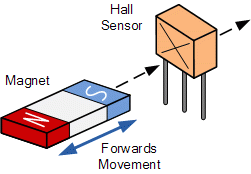The Hall effect is the working principle of the Hall sensor. It is a kind of electromagnetic effect, in which an orthogonal current and magnetic field are applied to the Semiconductor. The carriers in the Semiconductor are subjected to the Lorentz force and deflected. In different directions Gathering, thereby generating an electric field. There is a built-in voltage, this voltage is the Hall voltage, the greater the magnetic field strength, the greater the Hall voltage.

The working principle of the linear Hall sensor, the output of the linear Hall sensor is an electrical signal proportional to the measured magnetic field strength. For example, the linear Hall sensor 3503 has three pins which are positive VS, V out and GND. Among them The positive VS is connected to a power supply of 4.5 to 6V. Power is supplied to the 3503, and the GND is grounded. The shell of the 3503 can induce the magnetic field, and implements the magnetic field strength in the form of voltage output at the pin of V out. The next output diagram shows that the 3503 is good When the magnetic field strength is 0 Gauss, V out is equal to 2.5V. When the magnetic field strength changes by 1 Gauss, the output changes about 1.3 millivolts.
When the 3503 sensor measures the magnetic field, it needs to pass the magnetic field lines through its effective sensing element to be detected. The magnetic field lines pass through the Hall sensor. The stronger the magnetic field, the more magnetic field lines pass through the Hall sensor, and the weaker the magnetic field passes through. The fewer lines of magnetic force, the Hall sensor outputs a corresponding signal to indicate the strength of the magnetic field according to the number of magnetic lines that pass through.